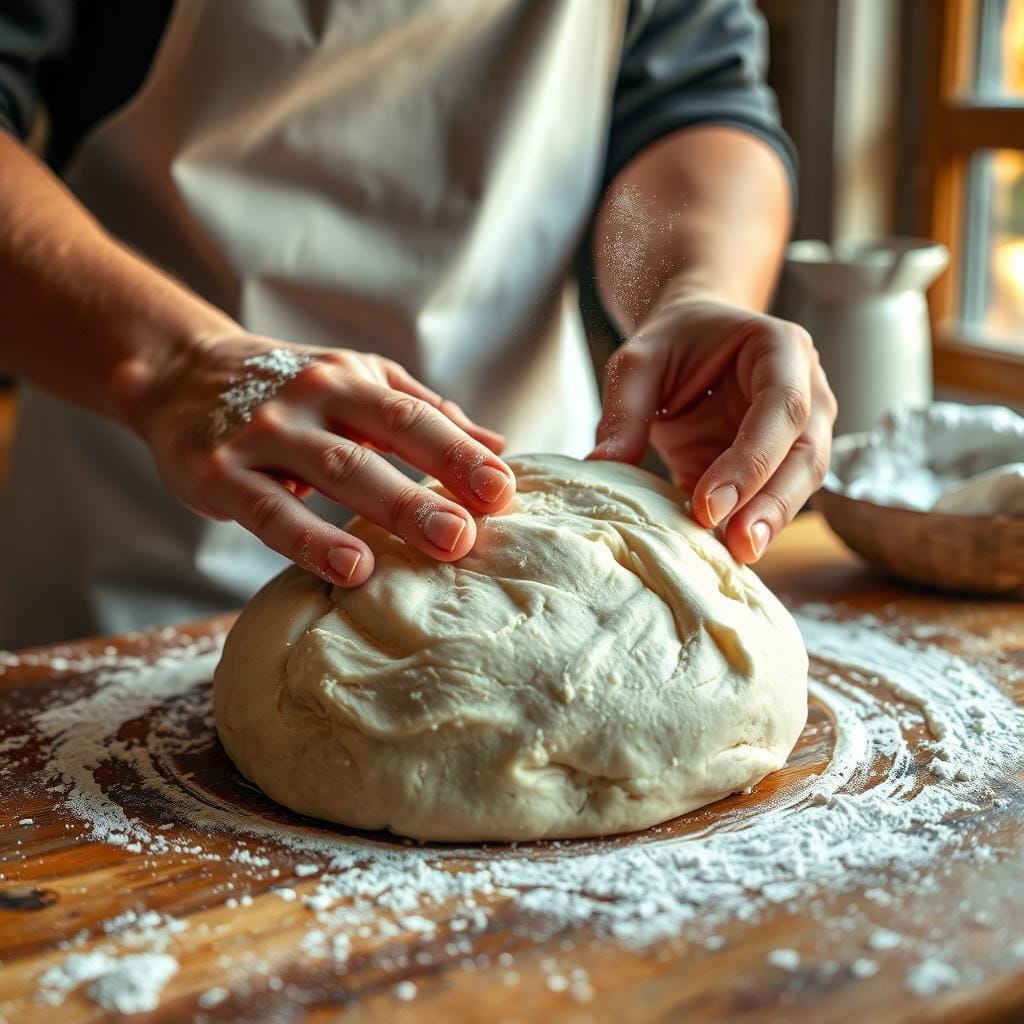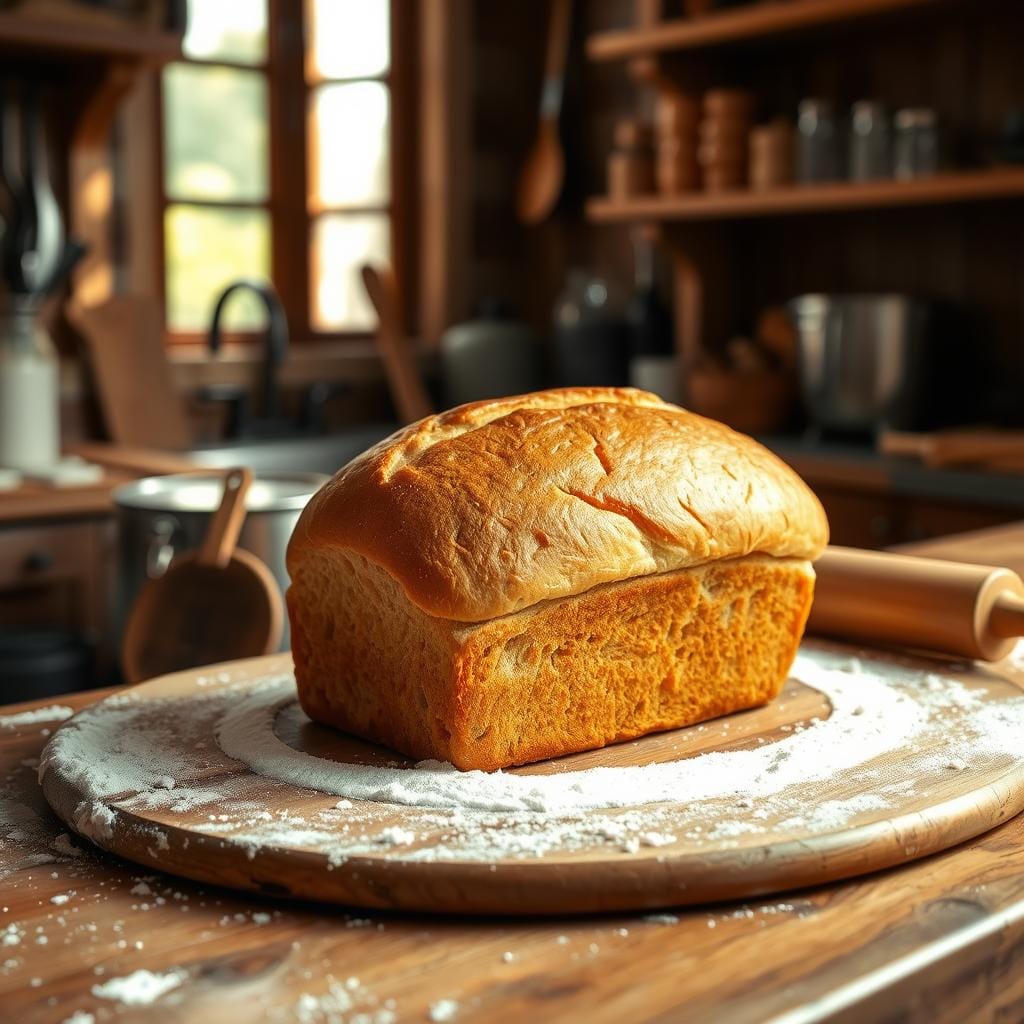The smell of freshly baked bread is a simple joy. It brings back memories of your grandmother’s loaves. This homemade sandwich bread recipe is a labor of love, but it’s worth every effort.
Key Takeaways
- This recipe yields a soft, fluffy, and delicious homemade sandwich bread
- Uses simple ingredients like unbleached all-purpose flour, active dry yeast, sugar, water, butter, and salt
- Step-by-step instructions guide you through the process of activating the yeast, kneading the dough, and baking to perfection
- Versatile recipe that can be used for sandwiches, toast, and more
- Suitable for home bakers of all skill levels
Irresistible Soft and Fluffy Homemade Sandwich Bread
Imagine biting into a soft, fluffy slice of homemade sandwich bread. This recipe is perfect for sandwiches, toast, and French toast. It’s made with love, giving you a tall, golden-brown loaf that’s a classic in any kitchen.
The Perfect Loaf for Sandwiches, Toast, or French Toast
This homemade bread is great for grilled cheese, club sandwiches, or French toast. Its tender crumb and lofty rise make it versatile. You’ll love the quality and taste of this freshly baked loaf.
This homemade sandwich bread recipe produces a soft, fluffy, and irresistible loaf that is ideal for a variety of uses.
| Ingredient | Quantity |
|---|---|
| Unbleached All-Purpose Flour | 500 grams (approximately 4 cups) |
| Warm Water | 1 1/4 cups (120°F – 130°F) |
| Active Dry Yeast | 1 1/2 teaspoons |
| Granulated White Sugar | 1 tablespoon |
| Sea Salt | 1 1/2 teaspoons |
This homemade soft sandwich bread recipe is crafted to perfection. It yields a tall, impressive loaf with a soft, fluffy crumb and a beautifully golden-brown crust. Prepare to be amazed by the superior quality and taste of this freshly baked homemade white bread.
Essential Ingredients for Soft Sandwich Bread
Making the perfect homemade sandwich bread needs the right ingredients. You’ll need unbleached all-purpose flour, active dry yeast, water, milk, butter, sugar, and salt. These ingredients make the bread soft, fluffy, and delicious.
Unbleached All-Purpose Flour for the Best Texture
Unbleached all-purpose flour is the base of this sandwich bread. It has just the right amount of protein and flavor. This ensures the bread is soft but still holds its shape well. Plus, it tastes pure and clean, enhancing the other flavors.
Active Dry Yeast: The Key to a Perfectly Risen Loaf
Active dry yeast is what makes the dough rise into a beautiful loaf. It makes the bread light and airy inside, with a golden crust. This crust is both beautiful and delicious.
| Ingredient | Quantity |
|---|---|
| Unbleached All-Purpose Flour | 6 1/4 cups |
| Active Dry Yeast | 1 tablespoon |
| Lukewarm Water | 2 1/2 cups |
| Milk | 1 1/4 cups |
| Butter, Softened | 3 tablespoons |
| Sugar | 2 tablespoons |
| Salt | 1 teaspoon |
With these ingredients, you’re ready to make a soft, homemade sandwich bread. It’s great for sandwiches, French toast, and more.
Activating and Blooming the Yeast
The first step in making this tasty homemade sandwich bread is to activate and bloom the yeast. This makes sure the yeast is alive and ready to make the dough rise perfectly.
Begin by mixing warm water, active dry yeast, and a bit of sugar in your stand mixer’s bowl. Let it sit for about 5 minutes. During this time, the yeast will become foamy, showing it’s ready to mix into the dough.
This blooming step is key to getting the most out of the yeast. It lets the yeast create the carbon dioxide that makes your bread soft and airy. By properly activating the yeast, you’re setting up your bread for a beautiful rise that will impress everyone.
After the yeast blooms, you can move on to the rest of the bread-making steps. Watch the mixture closely to ensure it gets to the right foamy state before going further. With this important step done, your homemade sandwich bread is on its way to being a hit.
Kneading the Dough for the Perfect Texture
Proper kneading dough technique is key for a soft and chewy texture in homemade sandwich bread. After activating the yeast, knead the ingredients together. You can use a stand mixer’s dough hook or knead by hand on a lightly floured surface.
Tips for Proper Kneading Techniques
Here are a few important tips for successful bread dough kneading:
- Keep the dough slightly tacky to the touch, but not overly sticky.
- Avoid over-kneading, which can make the bread tough. Aim for 5-8 minutes of kneading.
- Do the windowpane test to check if the dough is kneaded enough. Stretch a small piece of dough. If it forms a thin, translucent “windowpane” without tearing, it’s ready.
Kneading the dough right is crucial for the perfect homemade sandwich bread. Follow these tips for a soft, chewy loaf with great texture.
The First Rise: Allowing the Dough to Double
After kneading your homemade sandwich bread dough, it’s time to let it rise. This step is key for the bread’s structure and flavor. The yeast makes the dough expand, making it light and airy.
To get a great loaf, let the bread dough rising until it doubles in size. This usually takes 1 to 2 hours, depending on your kitchen’s temperature. The best temperature for rising is between 75-100°F (24-38°C).
To start the first rise, gently put the kneaded dough in a lightly greased bowl. Make sure to coat all sides of the dough. Then, cover the bowl with a clean, damp towel or plastic wrap. Let it rest in a warm, draft-free area. Check the dough every 30 minutes or so until it doubles in volume.
“The first rise is essential for creating a light and airy crumb in your homemade sandwich bread.”
When the dough doubles, it’s ready for shaping and baking. This ensures your bread is well-structured and flavorful. It’s perfect for sandwiches, toast, or French toast.
Shaping the Dough for a Beautiful Loaf
After the dough finishes its first rise, it’s time to shape it. This step is key for a loaf that looks great and bakes evenly. It makes the bread perfect for slicing and serving.
To start, gently punch down the dough to get rid of air pockets. This ensures it bakes evenly. Then, roll it out into a rectangle, but don’t overwork it.
- Roll the dough up tightly, starting from the short end, to create a uniform loaf.
- Pinch the seam to seal it, and tuck the ends under to create a smooth, seamless top.
- Place the shaped dough into a greased loaf pan, making sure it fits snugly.
Shaping the dough helps it rise evenly and bake into a tall, impressive loaf. It’s great for sandwiches, toast, or French toast. A tight, uniform loaf means a beautiful crust and soft inside.

Remember, gentle handling and avoiding overwork are key. With practice, you’ll make loaves that look like they came from a bakery.
The Second Rise: Achieving the Perfect Rise
After shaping your homemade sandwich bread dough into a loaf, it’s time for the second rise. This step is key for a tall, well-risen loaf. The shaped loaf goes into a greased loaf pan and rises for about 1 hour.
The dough expands and rises up, usually about 1 inch above the pan’s rim. Keeping the right temperature and environment is crucial. The dough proofs best in a warm spot, around 78°F.
Watch the dough closely during this rise. It’s ready when it doubles in size and reaches the desired height. This rise makes your homemade sandwich bread soft and fluffy.
“The second rise is crucial for developing the bread’s structure and ensuring a tall, well-risen loaf in the oven.”
To get the perfect bread proofing, remember these tips:
- Let the dough rise in a warm, draft-free spot for the best results.
- Keep an eye on the dough to avoid over-proofing, which can make it collapse.
- Check if the dough has risen about 1 inch above the pan’s rim before baking.
With the second rise done, your homemade bread is ready for baking. Next, we’ll show you how to get that perfect golden-brown crust.
sandwich bread recipe
Make your sandwiches, toast, and French toast better with this homemade sandwich bread recipe. It’s easy to make and turns out soft and fluffy. This recipe is great for both experienced bakers and beginners.
The secret to this recipe’s success is in the yeast activation and kneading. Follow these simple steps to bake a golden-brown loaf full of flavor and texture.
This recipe makes two delicious loaves, giving you about 32 slices. Enjoy this versatile bread for sandwiches, toast, and French toast!
“This is the best homemade sandwich bread I’ve ever made. It’s soft, fluffy, and perfect for all my favorite sandwiches.” – Sarah, Satisfied Baker
Baking Your Homemade Sandwich Bread
Now that your dough has risen for the second time, it’s time to bake. The baking process is key to getting a golden-brown crust.
Achieving the Perfect Golden-Brown Crust
Preheat your oven to 350°F (175°C). Gently put the dough into a greased loaf pan. Put the pan in the oven and bake for 25-30 minutes. Rotate the pan halfway to ensure even browning.
As the bread bakes, the internal temperature should hit about 190°F (88°C). This shows your homemade sandwich bread is fully cooked and ready to come out.
When it’s done, you’ll see a beautiful, golden-brown crust. It’s crisp on the outside and soft inside. The smell of freshly baked bread will fill your kitchen, making it hard to resist.

“The golden-brown crust color is a true testament to the care and attention you’ve put into baking bread at home.”
With these tips, you’ll get that perfect, bakery-quality bread baking tips every time. Get ready to enjoy a slice of warm, freshly baked goodness!
Cooling and Slicing Your Homemade Loaf
Congratulations! You’ve just baked a fresh loaf of homemade sandwich bread. Now, it’s time to let it cool before slicing. This step is key for the perfect texture and crumb.
Let the loaf rest in the pan for 5-10 minutes after baking. This helps the interior finish baking and the crust set. Then, move the bread to a wire rack to cool completely, which takes about 15 minutes.
Patience is important when cooling your homemade sandwich bread. Rushing can make it gummy and uneven. Wait until it cools fully before slicing with a sharp serrated knife.
When ready to slice, use a gentle sawing motion. Avoid pressing down hard to keep the interior soft. Aim for slices that are 1/2 to 3/4 inch thick, great for sandwiches, toast, or French toast.
“The secret to perfectly sliced homemade bread? Patience and a sharp serrated knife.”
By following these simple steps, you’ll get a loaf of sandwich bread that’s soft, fluffy, and ready to enjoy in many ways.
Storing and Freezing Your Sandwich Bread
Keeping your homemade sandwich bread fresh is key, especially if you can’t eat it all at once. There are easy steps to keep your bread fresh and tasty for longer.
Storing at Room Temperature
Store your fresh sandwich bread in an airtight container or bag for up to 3 days. This keeps it soft and prevents drying out. Don’t put it in the fridge, as cold air makes bread stale faster.
Freezing for Long-Term Storage
To store for longer, slice the bread and freeze it for up to 1 month. Wrap each slice or put them in a freezer-safe bag, squeezing out air. This stops freezer burn and keeps the bread fresh. Just toast the frozen slices without thawing.
By following these tips for storing bread and freezing bread, your homemade sandwich bread will stay fresh and delicious. This way, you can enjoy your baking for weeks.
“Freezing bread is the best way to preserve its freshness and quality,” confirms the owner of Mighty Bread bakery in Philadelphia.
Conclusion
This homemade sandwich bread recipe is a must-try for any home baker. It’s perfect for sandwiches, toast, and more.
It’s easy to follow and has helpful tips. You can make a professional-quality loaf in your kitchen. It’s a great skill to have.
Whether you’re a pro or just starting, this recipe will impress. It uses simple ingredients like flour and Red Star Platinum Yeast. It’s versatile and can make multiple loaves or dinner rolls.
Try this recipe and enjoy baking your own bread. It’s easy and rewarding. You’ll soon be enjoying perfect homemade bread. Happy baking!

Easy Soft Sandwich Bread
Embark on the rewarding journey of baking gluten-free sourdough bread. This recipe guides you through fermenting and proofing to achieve a unique texture and tangy flavor. Perfect for those seeking a gluten-free option without sacrificing the artisan bread experience.
Ingredients
- 100g gluten-free sourdough starter
- 300g gluten-free flour blend
- 220g water
- 6g salt
Instructions
- Prepare the DoughCombine 100g gluten-free sourdough starter, 300g gluten-free flour blend, 220g water, and 6g salt in a stand mixer. Mix until a cohesive dough forms.
- Ferment the DoughShape the dough into a ball and place it in a bowl. Cover and let it ferment at room temperature for 6-10 hours, allowing it to develop its tangy flavor and airy texture.
- Refrigerate for ProofingTransfer the dough to the refrigerator and let it proof for 12 hours. This slow proofing process enhances the bread’s flavor and texture.
- Shape and ScoreOn the second day, shape the dough into a loaf. Score the top with a sharp knife to allow for expansion during baking.
- Bake the BreadPlace the shaped dough in a preheated Dutch oven. Bake at 450°F (232°C) for 50 minutes or until the internal temperature reaches 210°F, ensuring a crusty loaf and fully cooked interior.
Notes
- For best results, use a sourdough starter that’s at least 2 weeks old for better rise and tangier flavor.
- Proof in a medium bowl for optimal shape, and ensure the internal temperature reaches 210°F for perfect doneness. Let the bread cool completely before slicing to improve texture.
Nutrition Information:
Yield: 7 Serving Size: 1Amount Per Serving: Calories: 182Total Fat: 1gSaturated Fat: 0gTrans Fat: 0gUnsaturated Fat: 0gCholesterol: 0mgSodium: 335mgCarbohydrates: 38gFiber: 2gSugar: 0gProtein: 5g
FAQ
What ingredients are needed to make this classic homemade sandwich bread?
To make this soft, fluffy sandwich bread, you’ll need a few key ingredients. These include unbleached all-purpose flour, active dry yeast, water, milk, butter, sugar, and salt.
How do I activate and bloom the yeast for this recipe?
To activate the yeast, mix warm water, yeast, and a bit of sugar in a stand mixer bowl. Let it sit for 5 minutes. During this time, the yeast will become foamy and ready to use.
What are the tips for properly kneading the dough?
For great kneading, keep the dough slightly tacky. Don’t overdo it. Also, do the windowpane test to check if the dough is kneaded enough.
How long should I let the dough rise for the first and second rises?
Let the dough rise for 1-2 hours for the first rise. It should double in size. For the second rise, wait about 1 hour. It should rise about 1 inch above the pan rim.
How do I properly shape the dough for baking?
After the first rise, punch down the dough to get rid of air pockets. Then, roll it into a rectangle and roll it up tightly. This makes a uniform loaf.
What temperature should I bake the bread at, and for how long?
Bake the bread at the right temperature for 25-30 minutes. It should turn golden-brown on the crust and have an internal temperature of about 190°F.
How should I store and freeze this homemade sandwich bread?
Store the bread at room temperature in an airtight container or bag for up to 3 days. For longer storage, slice and freeze it for up to 1 month.





